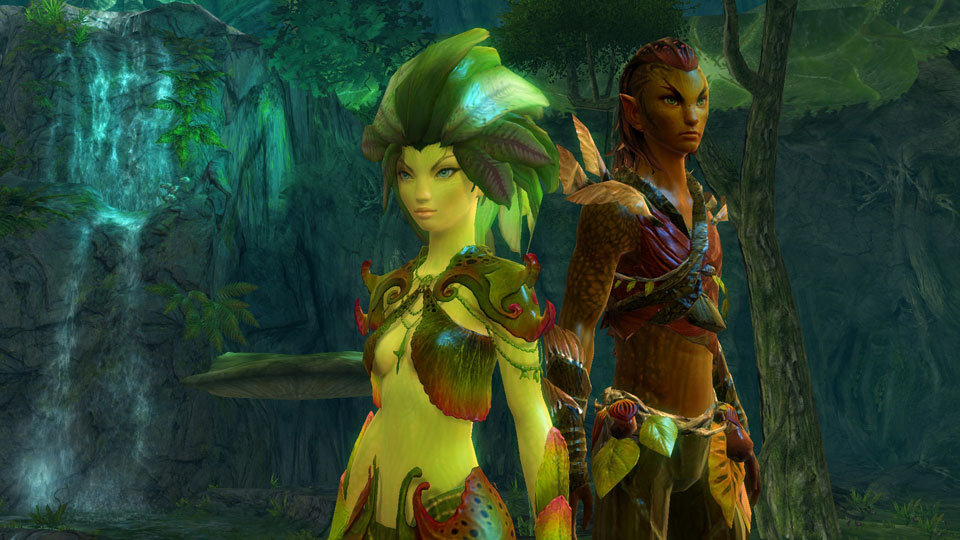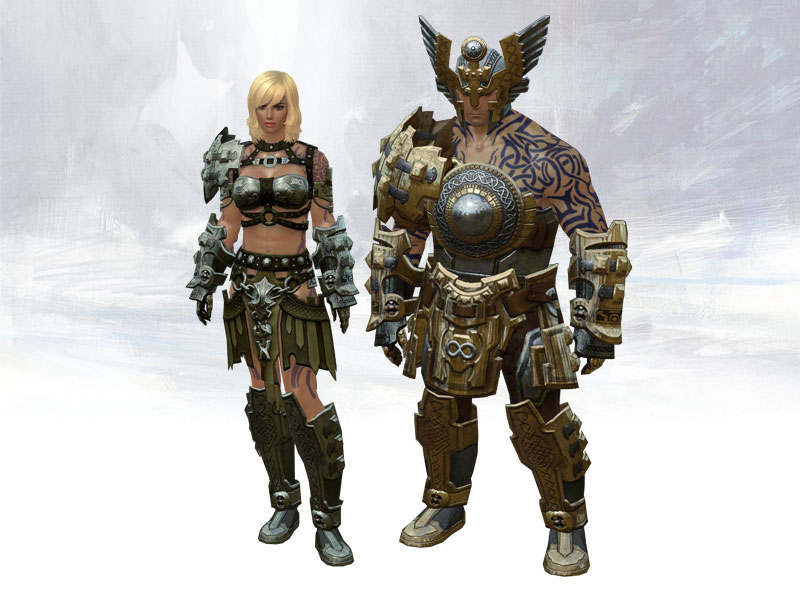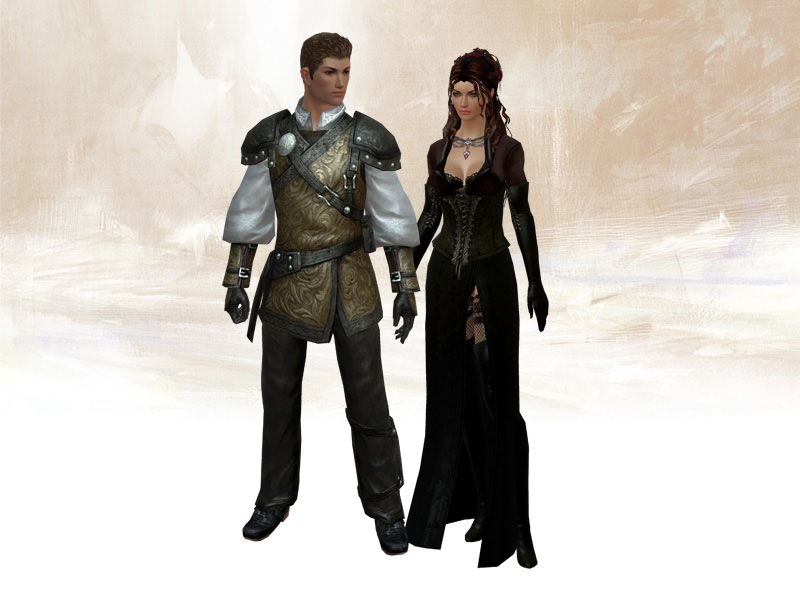Races
Sylvari
Pale Tree grew, branches arching over the forest, until at last--twenty five years ago--it bloomed, and the Firstborn stepped into the world. They were followed by their brethren, season after season of sylvari, wide-eyed with wonder and searching for purpose in this strange land. Shaped first by the Dream that nurtured them before they awakened, the sylvari now travel Tyria seeking adventure and their place in the world. They struggle to balance curiosity with duty; eagerness with chivalry; and warfare with honor.
The Dream still lingers in their souls, like an echo of a distant song. Through it, they can sense the ebb and flow of their race, feel the empathic connections between all sylvari, and share their discoveries and knowledge like water into a river's current. They have a deep connection with the land and the riches it bears, and know that all things which grow and blossom are their brethren. Guided by the lessons carved into the sacred Ventari Tablet, they have built a city within the forest, and created a culture that blends the mystery of magic with a steel-tempered resolution to do good.
But not all sylvari are noble, and not all Dreams are pleasant. Some of the children of the Pale Tree walk a shadowed path, devoted to a Nightmare that boils beneath the surface and whispers of dark moons, wicked revels, and terrible secrets murmured at midnight. The Nightmare Court rejects the virtues of their brethren and seeks to draw all sylvari toward their sinister philosophy. If they are not stopped, they will taint the Dream with their evil deeds and corrupt the Pale Tree herself, condemning the noble race of sylvari to a future of vice and corruption. In the battle between Dream and Nightmare, the fate of the newest race in Tyria will be determined by heroes.
Norn
The norn are a race of valiant, shape-changing barbarians. Boisterous, strong-willed, and passionate, the norn are an independent people that swear fealty to no single being. They thrive in their mountain stronghold by the sharpness of their senses, the quickness of their wits, and the strength of their massive forearms. They are guided in this world by their Spirits of the Wild, who embody the virtues of the mightiest beasts. As a people, they are quick to anger, even quicker to smile, and treat each new day as a personal challenge. They drink and feast and hunt with equal gusto, and fear few things. They are steadfast allies and implacable foes.
History
The norn hail from the frozen mountains of the Far Shiverpeaks, leagues to the north of the human kingdoms. Their history is one of heroes, spirits, and impossible deeds. A norn warrior remains immortal only as long as she is remembered by descendents and only as long as her songs are sung by skaalds around the lodge fires. So it has been for times uncounted.
This changed with the arrival of Jormag, the Elder Ice Dragon. Stirring from its frozen sleep, the dragon erupted into the living world. The norn first fought it in the manner that they had always fought--as valiant heroes seeking to defeat the beast in single combat. Hundreds were slain, and the norn themselves forced from their homelands.
The Spirits of the Wild aided the norn in their flight. Some died protecting them; some remained behind to fight Jormag and were lost. Others, the greatest of their spirits--Wolf, Bear, Raven, and Snow Leopard--guided the norn to safety in lands once belonging to the dwarves.
Hoelbrak
The norn are not a people of cities--they prefer simple steadings carved out of the wilderness, where survival depends upon one's own power and ability. Yet Hoelbrak acts as a focal point of norn civilization, for it is here that the Spirits of the Wild led the great hero Aesgir and the fleeing norn to safety. In the years since its founding, norn from all over the Shiverpeaks have come here to trade, to meet, to brag, and to drink, but only a few have made it their year-round home.
Knut Whitebear, Aesgir's grandson, now oversees Hoelbrak, but any attempt to call him their ruler would be met with derision. Knut's title is Master of the Lodge. He keeps Hoelbrak safe, as his father and grandfather did before him. He tests the young and celebrates their achievements with great moots. The Wolfborn, led by his two sons, keep the peace among these brawling, argumentative people.
Five great structures dominate Hoelbrak. The Great Lodge is Knut's domain, and in its high galleries and balconies one can find the greatest heroes of this people. Each of the other four lodges is dedicated to one of the four Spirits of the Wild--Wolf, Bear, Raven, and Snow Leopard. Here work the shamans that keep alive the faith and the skaalds that tell the old tales of those who have gone before. Here is where the wisdom of the norn survives.
The Spirits of the Wild
The norn have no gods in the human sense of the word. Instead, they venerate the Spirits of the Wild: totemic powers, the great spirits of the wild creatures. Each totem has virtues and lessons to teach the norn: Bear has her strength; Wolf teaches unity in numbers; Raven is wisdom; Snow Leopard speaks of cunning and stealth. There are other spirits, too, some unworthy of veneration, some dead, some merely missing.
The norn have the ability to shape-change into forms beloved by the Spirits. While transformed, they become closer to those spirits and to understanding the power of the wild. Norn enjoy the bounty of the land, but they do not despoil it, for the wisdom of the Spirits brings them an understanding that tempers their direct, quick-tempered natures.
New Challenges, Ancient Enemies
The norn have spread through the Shiverpeaks, and their distinctive homes can be found near the best hunting grounds and the clearest streams. They are not alone in these new lands, however, and must fight for their homes--which is just as the norn want it.
Long ago, the dwarves ruled these deep valleys and cavern-riddled mountains. These diminutive warriors descended into the depths, transformed by ancient magic to fight the minions of a different Elder Dragon. Now their ruined homes have been usurped by their former slaves and servants, the dredge, who claim all the lands below the surface as their own and vie with the norn for the lands above.
The mountaintops are home to another fallen race, the jotun. These giants were once wise and powerful, and their fall has been long and hard. Now little more than savages surviving in the wreckage of their ancestors' citadels, they challenge the norn for domination.
Yet the greatest danger to the norn has followed them from the north. Jormag's champions and minions are abroad in the land, corrupting the pure snows and powerful creatures with its icy breath. Worst of all, there are those among the norn themselves who recognize Jormag's power. They revere Dragon as if it were another Spirit and seek to learn from it and master its abilities. Only too late do they discover their error: Dragon teaches only corruption and death.
The Power of the Norn
Jormag drove them from their original homeland, but the norn are no refugees, battered and seeking aid. Rather, they see the Elder Dragon as merely another challenge to be bested. If not today, then soon. Until that day comes, until the hero who will shatter the tooth of Jormag arises and shows the norn the way back to their northern homes, the norn will live each day as if it were their last. The living world is a wondrous place for them, filled with challenges, struggles, and the potential for great stories
Charr
The thundering sound of their advancing war machines makes the lesser races tremble with fear. They are the charr, and conquest is their birthright.
The charr race was forged in the merciless crucible of war. It is all they know; war defines them and their quest for dominion drives them onwards, always onwards. The weakling and the fool find no place among the charr.
Many generations ago, the charr overthrew their religious caste and reestablished the ancient Legions, the foundation of their military culture. The charr turned their backs on the false gods and embraced industry, creating weaponry and great machines of war as deadly and unforgiving as the charr themselves. They use any means available to crush their foes--be it ambush, bombardment, or claw and fang. Victory is all that matters, achieved by any means and at any cost.
The charr train from youth to be warriors. Their society is organized into war bands, companies, and the four great legions. Ash Legion, Blood Legion, and Iron Legion are loosely allied, while the treacherous religious zealots in the Flame Legion conspire against them all. Today, conquered Ascalon is the homeland of the mighty Iron Legion, but even under charr rule it is still a nation at war. Operating out of the massive Black Citadel, the three legions battle against human rebels, the ghosts of long vanquished Ascalonians, and a tyrant of the Flame Legion who seeks to make himself a god. The charr have never had a shortage of enemies, and they wouldn't have it any other way.
Asura
They may be short in stature, but this subterranean race of magical inventors are intellectual giants. These incredibly intelligent beings use their knowledge and skill with magic and crafting to assert their natural dominance. In the world of the asura, it is not the strong who survive, but the clever. Other races believe they should rule by virtue of their power and strength, but they delude themselves. All will serve the asura - in due time.
Driven to the surface of Tyria by minions of Primordus, the Fire Dragon, the asura have created a complex new society based in vast Maguuma Jungle metropolises like the awe-inspiring Rata Sum. Asura life is based around the study of the Eternal Alchemy, an all-encompassing metaphysical theory that they analyze in their great research institutions - the College of Statics, Dynamics, and Synergetics.
Asura use their magical skill to create servitor golems, asura gates, blasting rods, and other magnificent inventions. Their culture is organized, but highly flexible--these small geniuses often gather in specialized work groups called "krewes" to accomplish greater tasks. Asura establish their reputations with their peers by building a portfolio of successful projects or by becoming the foremost expert on some arcane field of study. They constantly seek to prove their own intellectual superiority, and by extension the superiority of the asura race.
Who are more fit to rule Tyria than the asura? The more primitive, warlike races can be useful when an asura needs something heavy lifted, but they mistakenly believe that brute force or resiliency entitles them to power. How mistaken they are. As any asura will explain, mastery of the Eternal Alchemy equals mastery of Tyria. Who can argue with such logic?
Human
The humans of Tyria are an embattled race. Over the past three hundred years, they have lost much of their territory. Old enemies and new races threaten traditional human lands on all sides. Yet the human race survives, defending their remaining lands and maintaining the human spirit as they have for centuries. Their greatest city, Divinity's Reach, shines as a beacon of hope for the people of Kryta and beyond--even those dwelling deep within charr territory. The human legends are indelibly imprinted on the souls of all the races of Tyria, be they friend or foe.
This is their story.
History
The humans of Tyria originally came to this part of the world from the south. They soon spread throughout the kingdoms of Orr, Kryta, and Ascalon, displacing other peoples, including the centaurs and charr, in the process. Internal squabbles and wars weakened the human nations, so that they were in no shape to defend themselves when the charr invaded Ascalon.
Ascalon fell before the charr magic of the Searing. Rather than surrender to the charr, King Adelbern invoked the Foefire, a powerful curse that transformed his people into ever-vigilant ghosts. Orr vanished beneath the sea, only to rise years later as a kingdom of the undead ruled by the Elder Dragon Zhaitan. Lion's Arch was inundated and then reborn as a city of many races. Kryta plunged into civil war, and only survived due to the actions of its valiant heroes.
Yet through it all, humanity persevered, protecting the best qualities of its people and history. Although surrounded by challenges and confronted by threats within and without, the race survives and thrives in a world that becomes more deadly by the day.
Divinity's Reach
Humanity's greatest city is Divinity's Reach, founded in the wake of the flooding of Lion's Arch. Built upon ancient Krytan tombs and situated on a bluff, the city provides a strong bastion against a dangerous world. Survivors of the other human nations and refugees from distant lands have poured into Divinity's Reach, swearing fealty to the crown and creating a proud, beautiful city.
The city is laid out like a great wheel with six spokes. These spokes are elevated high roads which reach from the outer walls to the Central Plaza at the city's hub. It is here that a great orrery spins beneath a massive dome of copper and glass, here that the ministers squabble, and here that Queen Jennah rules with a confident hand.
Threats Without and Within
From Divinity's Reach, the long reach of human power stretches out across the surrounding hills and farms, offering protection to the farmers and townsfolk of Kryta. These people are under constant siege from centaurs that have come down from the mountains. The powerful Modniir centaurs have established dominance over the weaker Tamini and Harathi breeds and now urge them to attack human enclaves across Kryta. These raids are major incursions that sometimes reach the gates of Divinity's Reach itself.
Not all enemies are inhuman. Bandit gangs have sprung up in areas beyond the reach of the law, and now large, organized groups of them prey on the local citizenry. The Seraph are entrusted with protecting the people, but they are stretched thin by the sheer number of their opponents.
As if matters were not dire enough, dissension flourishes within the walls of Kryta itself. Queen Jennah is beloved by her people, but the nobility often chafes at her egalitarian rule and the truce that she has forged with the legions of the charr. The Chamber of Ministers is a hotbed of intrigue and plotting, much of it centering on Legate Minister Caudecus the Wise, who many see as a rival of the Queen herself.
The Heritage of the Humans
With the defeat of Abaddon, the human gods withdrew from Tyria. They did not abandon their worshippers, but rather pulled back from directly interfering in their daily lives. Much like parents teaching a child to walk, they let humanity stumble forward and learn to pick itself up when it fell.
The humans of Divinity's Reach realize this and know that the gods expect them to stand on their own. The names of the Six Gods (now called the Six Human Gods by other races) are on their worshippers' lips, and there are still shrines and priests of the faith. Humans do not feel abandoned by their gods; they feel tested by them. As a people they refuse to fall.
Humanity's long history makes other races think of them as hidebound, old-fashioned, and conservative, but they are not afraid of new things. With the rise of other major races, they have sought to adapt and compete with them. They are interested in asura gate technology and charr weaponry. Humans are a people of tinkerers and craftsmen; inventors such as Uzolan the Artist help refine and expand upon their technical knowledge.
Humanity's greatest heritage is heroism. Even the youngest sylvari knows about the great figures of Tyrian legend. It is in their footsteps that the other races must follow.







